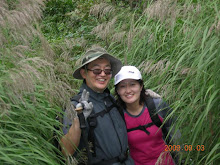The late Joseon Kingdom (1392-1910) was called the ``Nation of Hats'' by foreigners. American astronomer and author Percival Lowell (1855-1916), who visited the Joseon Kingdom, particularly noted that its hats were the most impressive among others for their diversity, originality and practicality in his book ``Choson (Joseon), the Land of the Morning Calm'' in 1885.
The hats in the late Joseon period were diverse and creative in function and purpose, compared to Western hats used to complement clothing. To show off this Korean headgear, the Coreana Cosmetics Museum is holding an exhibition of a collection of some 100 Joseon hats and photos.
The hats served a variety of purposes ― protection from cold and heat, decoration and fashion and a means to represent social status and formality. Especially, in Joseon, a country of ``yangban,'' or noblemen, they were widely used to denote social status. ``The dresses and ornaments, including hats, particularly thrived in the Joseon Kingdom. Confucianism was attributed to diverse development of the hats as they represented the wearers' social status and rank,'' said Lee Ji-sun, a curator of the museum. She also said that men's headdresses were more diverse than women's, which means the state philosophy restricted women's outdoor activities. ``Through the hats, visitors can better grasp Joseon's social culture,'' she added.
The exhibition is comprised of six parts ― indoor, outdoor, practical, ritual, women's and court headwear. The indoor section shows yangban culture as they thought showing their bare topknot-hairstyle was indecent and thus they had hats such as ``geon'' and ``gwan'' as part of their everyday wardrobe at home.
The curator said that the indoor hats were similar to outdoor ones as men had to adhere to basic formality even indoors. The indoor hats are divided into geon that simply covers the head and gwan that indicates rank. Originally, gwan were derived from geon, but the former became more structured and decorated.
Horsehair was a favored material for the headwear in late Josen. Woven from horsehair, ``tanggeon'' took on an incomplete conical shape. Men wore it indoors by itself or under their ``gat,'' or official hat. Men wore a horsehair woven headband, called ``manggeon,'' around their foreheads after tying their hair up into a topknot. Confucian scholars preferred ``bokgeon,'' or soft cone-shaped hoods made of black cloth, and ``yugeon,'' folded rectangular-shaped hats made of black hemp or horsehair. With the attached strips on each side tied at the back, the basic shape of the ``bokgeon'' was a long narrow cloth folded in half.
Gwan were usually made from horsehair and could be folded for easier storage. ``Jeongjawan'' made of horsehair, was one of the indoor hats worn for everyday attire and usually consisted of double or triple layers.
The outdoor headdress section features various ``gat'' that refers to any hat with a brim. ``Gat'' are divided into the two shapes ― ``paeraengi'' with a crown and a brim, and ``satgat'' a conical-shaped hat with a hexagonal frame. The characteristic hat for a noblemen, ``heungnip,'' was worn with everyday clothes. ``Jurip'' painted with red lacquer was worn with ``yungbok,'' or attire officials wore when accompanying the king or confronting serious issues such as war. ``Bangnip'' was worn for state funerals.
Exclusively worn by noblemen, heungnip had no practical functions such as protection from the sun or rain until 1895, when the lower class was allowed to wear ``gat.''
To endure the long and harsh winter, various types of winter caps such as ``nambawi,'' ``pungcha,'' and ``hwihang'' were widely worn. The chief characteristic of the Korean traditional winter cap is the opening of the crown. Worn both by women and men, pungcha and nambawi have a longer back piece that falls to the nape of the neck.
In the Joseon period, women usually wore ``sseugae'' or a skirt-shaped veil to conceal their faces from men. Woman had to cover their faces when going outside. ``Jangot,'' a cloak-shaped veil was one of the face-covering headdresses that the Joseon women wore. In the early period, noble women wore ``neoul,'' or a black sheer silk veil that covered from the head to waist. Since the noble ladies preferred to travel by palanquin rather than by horse or donkey, they favored the sseugae and jangot which were more convenient to remove, carry and store. The noble women wore neoul, while the lower-class women sported jangot and ``gisaeng'' (female entertainers) wore ``jeonmo,'' an umbrella-shaped oiled hat that revealed the face. Veiling the face and body was not convenient for women in the working place, but fitted to noblewomen who didn't work. Thus, wearing sseugae was one of the things that made lower-class women envious.
At the royal court, the kings wore ``myeollyugwan,'' a square, flat crown with dangling strings of small precious stones with formal attire in the major rituals of the coronations and wedding ceremonies. Also, ``ikseongwan'' was worn when the kings worked at court for state affairs.
The exhibition will continue through Oct. 30 on the sixth floor of the museum located in southern Seoul. Admission is 3,000 won. For more information, call (02) 547-9177



No comments:
Post a Comment